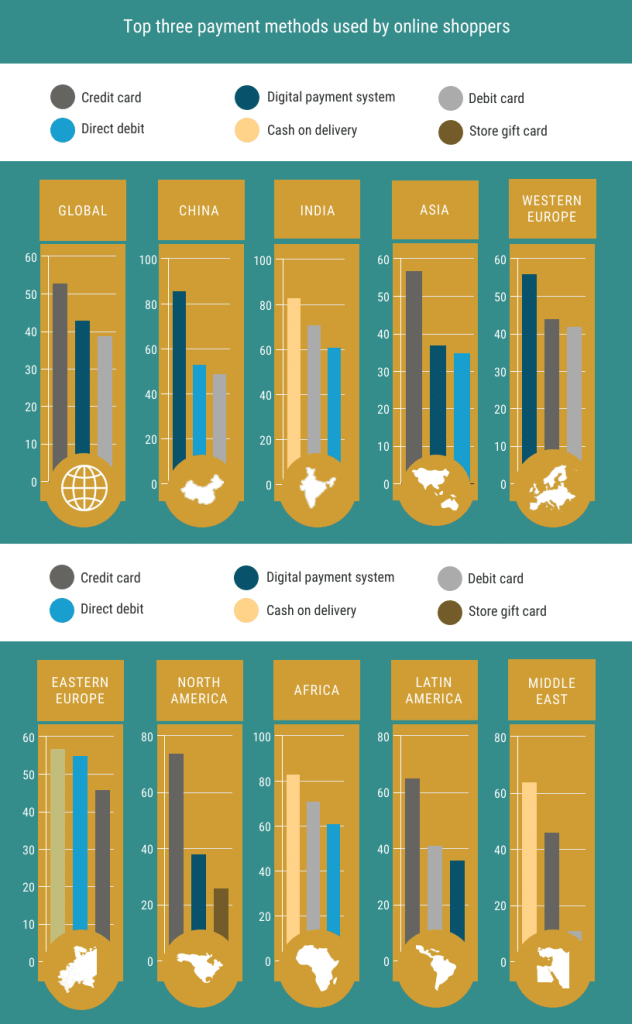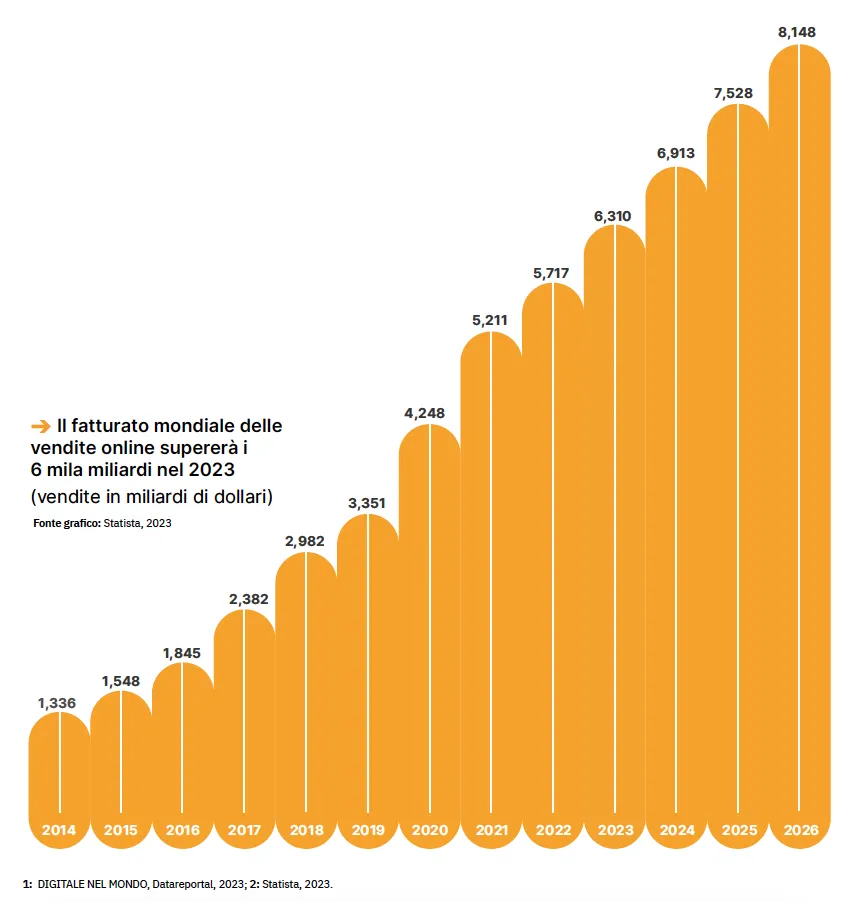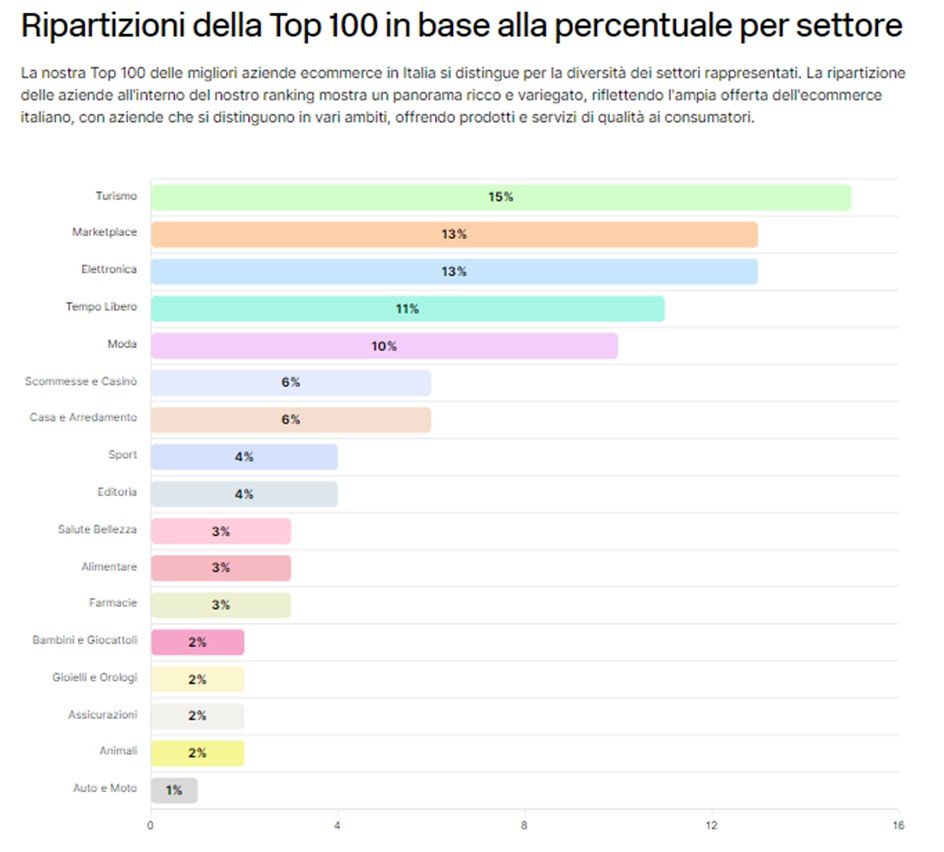Table of Contents
E-commerce has taken an incredible leap in how we enjoy shopping, transforming the traditional act of shopping into a virtual store accessible with a click from anywhere in the world.
Online commerce is not just a change; it’s a real revolution driven by a team of factors that make e-commerce the undisputed king of global trade.
In all this, businesses must be ready to keep up with the pace of new trends, challenge consumer expectations, and go beyond by investing in cutting-edge technologies and focusing on providing a smooth and personalized online shopping experience.
Only through this constant ability to adapt can businesses shine in an increasingly digitized world crowded with competitors.
In this article, we will explore all the innovations expected in the world of e-commerce and what sells more online according to the latest trends.
Innovative Technologies for Online Shopping
Increasing Use of Augmented and Virtual Reality: Exploring Products in an Innovative Way
Imagine being able to explore your next purchase without ever leaving your home, to interact with products as if you had them in your hands. Augmented and virtual reality have opened a magical window in the world of e-commerce, taking the concept of ‘try before you buy’ to new levels.
With augmented reality, buyers can view products in a real-world context through the use of their own devices. Whether it’s furniture in your living room or a pair of shoes on your foot, augmented reality offers a tangible perspective before making a purchase.
These technologies not only make the online shopping experience more engaging but also reduce the uncertainty associated with online purchases, increasing consumer confidence. For businesses, they represent a unique opportunity to differentiate themselves by providing customers an experience beyond just static product displays.
Impact of User Experience Personalization: A Tailored Purchase for Every Customer
Personalization in e-commerce has revolutionized the relationship between the customer and the brand. In practice, it involves creating a tailored shopping experience for each user based on their tastes and personal preferences. This translates into the feeling of entering a store where all products seem to have been specially chosen for us.
To make this personalization possible, e-commerce platforms use data analysis and artificial intelligence. These tools enable understanding each user’s past purchasing behavior, as well as their preferences and even browsing style on the platform. The collected data fuels intelligent algorithms that provide personalized recommendations, product suggestions, and special offers.
The result of this personalization is a unique shopping experience for each customer. It makes customers feel understood and appreciated, as the proposed products genuinely align with their preferences. This approach not only increases customer satisfaction but also enhances the likelihood of making a purchase and fostering long-term customer loyalty. Companies embracing personalization are creating a stronger bond with their customers, transforming every online visit into a personalized and tailored experience.
Trends in 2024 for Electronic Payment Systems
Digital transformation in the electronic payments sector is driving several trends that will shape the industry’s future in 2024. One of the most relevant developments is omnichannelity, the ability to use various platforms to conduct transactions. More and more consumers are adopting this mode, using both their smartphones and computers, for example, to make their purchases. This trend is made possible through the integration of advanced technologies, such as artificial intelligence, which contributes to increasing the efficiency and security of payment systems.
The fintech sector, indicating the use of digital technologies in the financial industry, is undergoing significant evolution. One of the most relevant trends is the increasing adoption of unique physical traits used as security measures in transactions. For instance, fingerprints, facial recognition, and voiceprint analysis are expected to be increasingly used to ensure a higher level of security in payments. These techniques allow for the unequivocal identification of the user and reduce the risk of fraud.
In the context of mobile commerce, which refers to purchases made through mobile devices, there is continuous growth. This confirms the increasing importance of mobile devices in financial transactions. More and more people use their smartphones or tablets to shop online or pay in physical stores, making it essential for businesses to provide a platform and payment experience optimized for mobile users.
Buy Now, Pay Later (BNPL), the payment method where a product is purchased, and payment is made later, emerges as a key element in payment trends. This model offers consumers greater flexibility and convenience in managing their payments, allowing them to buy goods or services even if they do not have the necessary funds at the moment.
Security of Online Transactions

Payment method security in 2024 is a crucial aspect that must be taken very seriously, especially considering the increasing digitization and evolution of financial transaction methods. To ensure secure transactions and protect financial information, it is essential to adopt robust security measures.
Some key aspects include:
- Encryption and Online Transaction Security: With the growing number of online transactions, it is crucial to ensure a high level of encryption to protect financial data during transmission. The use of advanced security protocols, such as SSL/TLS, is a necessary practice to ensure the confidentiality of information.
- Continuous Updates and Security Patches: It is essential to keep payment methods up-to-date with technological advancements and cover any vulnerabilities that could be exploited by malicious actors.
- Multi-Factor Authentication (MFA): Requiring more than one verification method, such as a password, OTP codes, or the use of biometrics, enhances protection against unauthorized access.
- Anomalous Transaction Monitoring: Payment systems should incorporate advanced monitoring tools to detect suspicious activities or unauthorized transactions. Behavioral analysis and the use of artificial intelligence can be employed to identify fraudulent activities.
- Secure Payment Technologies: Digital payment methods must integrate advanced technologies to prevent fraud and ensure security.
- Regulations and Compliance: Adopting compliant practices contributes to ensuring the security and protection of payments.
The main digital payment methods currently dominating the landscape are:
- Buy Now Pay Later (BNPL): Allows consumers and businesses to make purchases and defer payment to a later date, offering payment flexibility and the ability to spread the cost over time.
- Pay by Link: A solution that allows the seller to send a direct payment link to the customer, making the transaction process smoother without the need to enter credit card details.
- Request to Pay: Adds interactivity to the payment process, with the seller initiating the procedure and taking control of their collection.
These tools offer greater flexibility, security, and efficiency, highlighting the trend towards an increasingly smart approach in the future of business payments.
In summary, in 2024, the security and flexibility of payment methods are a priority in a context where digital transactions are becoming more widespread. The combination of advanced technologies, preventive measures, and user awareness is essential to create a secure and reliable payment environment.
Innovative Implementations: Logistics and Delivery in 2024

The landscape of logistics and deliveries in 2024 is undergoing a significant transformation with the introduction of innovative implementations. One of the key trends in this sector is the digitalization of logistics processes, aiming to optimize operations through the use of advanced technologies. One of the main advantages of this digitalization is the ability to monitor real-time stock levels, allowing for more efficient management.
Furthermore, warehouse automation and robotics are becoming increasingly common as they contribute to increasing the speed and accuracy of operations. For example, specialized robots can be employed to perform repetitive tasks, leaving more complex tasks to human operators.
Artificial intelligence is playing an increasingly important role in the logistics sector. It is used in various stages, from planning to delivery management, to optimize operations. AI can analyze large amounts of data to identify possible inefficiencies and propose solutions to improve logistics.
In 2024, companies have the opportunity to empower the entire production and logistics system, exploring new growth opportunities. Integrated logistics is crucial to ensuring an efficient flow of goods, from acquisition to production and delivery stages.
With regard to logistics, a significant change is represented by the introduction of drones for deliveries, revolutionizing the logistics industry.
According to Amazon’s plans, by 2024, this innovative methodology will also be introduced in Italy. This new delivery method relies on the use of drones with cameras, capable of identifying the space needed for delivery and dropping packages at recipients’ doorsteps in less than 60 minutes.
Amazon’s drone delivery service is not considered a mere experiment but a concrete step towards real implementation of this technology, offering an alternative and complementary solution to traditional delivery methods.
The main goal is to reduce customer wait times and increase their satisfaction by facilitating the package delivery process. Moreover, the use of drones can reduce the workload of drivers and decrease traffic on the roads, contributing to a more sustainable environmental impact.
Integration of Artificial Intelligence in E-commerce
The integration of Artificial Intelligence in e-commerce is leading to a revolution in how businesses manage their online activities. This change not only affects industry operators but also has a significant impact on consumers. One key aspect of this transformation is the use of AI to personalize web content.
Thanks to Artificial Intelligence, companies can collect and analyze a large amount of data on customer behaviors, preferences, and needs using algorithms and technologies like Machine Learning. This enables them to offer a highly advanced and precise personalized user experience.
The integration of AI in e-commerce not only allows companies to provide personalized experiences to consumers but also leads to new strategies. One of these is the implementation of advanced product search, using AI capabilities to enhance the efficiency and accuracy of online searches. This means that the use of AI in e-commerce is bringing about an unprecedented change in the online shopping sector, visibly influencing the field of digital marketing as well.
It is important to emphasize that AI is not limited to large enterprises but can be easily accessible to small businesses as well.
Another rising trend is voice commerce, facilitated by voice assistants like Alexa and Siri. Algorithms such as Google’s BERT are adapted to the semantic web and can understand the meaning of voice searches. This means that retailers can leverage this technology to optimize product searches and enhance responsiveness to customer requests.
It is crucial to reiterate that AI is not just a user interface but is increasingly integrated into Customer Relationship Management (CRM) systems. AI-based CRM systems improve the customer experience and proactively suggest products. For instance, they can identify customer purchasing patterns and offer personalized recommendations based on them.
Furthermore, AI automates processes across different business departments, reducing time and human resources. Predictive analysis, one of AI’s features, helps understand and allocate resources based on sales and demand forecasts. This allows the company to manage its resources more efficiently, optimize operations, and maximize profits.
AI, whether based on machine learning or cognitive APIs, can automate processes, simplify planning, and save time, with specific benefits for e-commerce such as message personalization and retargeting.
The points where AI can be integrated into an e-commerce are manifold. For example:
- Implementing chatbots and virtual assistants to streamline customer support;
- Optimizing internal search functionality within the online store;
- Utilizing voice and visual search;
- Using AI to respond to reviews.
Sustainability in E-Commerce: Guiding the Change
The evolution of e-commerce towards sustainability in 2024 is a significant phenomenon that involves multiple strategic and behavioral aspects.
Among the various initiatives implemented to make e-commerce sustainable, we have identified some, including:
- A shift in the policy of free returns, especially in the fashion industry: fashion companies are starting to limit the use of free returns, aiming to reduce waste and promote sustainable practices. This trend may extend to other sectors of e-commerce.
- An increase in consumers opting for sustainable packaging in their purchases, including food and other products;
- Adopting principles such as quality, ethics, well-being, and customization in the production and sale of products to avoid the waste of resources.
The Key Trends for E-commerce in 2024: What Sells More Online

The e-commerce landscape has experienced remarkable growth, with forecasts indicating a turnover of 6 trillion dollars in 2023, expected to surpass 8 trillion by 2026. This expansion underscores the importance for businesses to adopt innovative approaches to remain competitive.
As for what sells the most online, the trends in fashion, electronics, sports and wellness, parapharmaceuticals, and health and beauty products are confirmed in 2024.
- Statistics on e-commerce usage between men and women: men spend about 68% more in their transactions compared to women, mainly because they purchase more expensive electronic items.
- Percentage of users making online purchases
- It is estimated that 95% of purchases will be made online by 2040.
Here is a list of the top 5 products to sell online in 2024:
1- Droni
2- Stampanti 3D
3- Online courses
4- Travel and tourism
5- Kitchen products
Not to be underestimated is the Affiliate Marketing technique, extensively discussed in our article ‘Affiliate Marketing: How to Earn Online with Winning Partnerships.’
Social Commerce e Live Commerce
In 2024, Social Commerce and Live Commerce are expected to continue growing rapidly, with a particular focus on popular platforms like TikTok.
The launch of TikTok Shop in 2023 has opened new opportunities for businesses, allowing users to make direct purchases on the platform. This integration of the sales channel and social platform enables TikTok to gather detailed insights into users’ viewing habits and purchasing preferences. This facilitates precise targeting and streamlines the purchasing process for businesses.
All of this highlights a significant transformation in how businesses can connect with their clientele and promote their products. The competition is constantly intensifying, and companies will be called upon to adapt to this change to maintain their competitiveness in the market.
Social media and digital communication channels are fundamental tools for e-commerce businesses. In 2024, it is predicted that companies will invest even more in producing high-quality content for these channels. This is because consumers increasingly seek information and direct interactions with brands on social media and digital platforms.
Online presence has become crucial for all businesses, especially for e-commerce companies, as it allows them to reach new customers, engage with existing ones, and build a positive brand image. Therefore, investing in creating captivating and informative content is essential to attract and engage consumers.
Furthermore, as mentioned earlier, social media provides businesses with the opportunity to gather direct feedback and reviews from customers, allowing them to improve products and services based on the needs and desires of the audience. This helps maintain customer trust and ensure the long-term success of the company.
Conclusions
Closing this journey through the 2024 e-commerce trends, it becomes clear that we are facing a digital future full of opportunities and challenges. Innovation is the key, and companies that embrace change are destined to thrive.
With the increasing use of augmented and virtual reality, consumers can now experience immersive online shopping, challenging the traditional barriers between the physical and digital worlds.
Each consumer is now at the center of a tailor-made experience, where personalized recommendations and ad hoc offers create a stronger bond between customer and brand.
In conclusion, 2024 promises to be a year of growth and innovation in e-commerce. It’s time to hoist the sails of change and navigate towards an exciting digital future in e-commerce.
